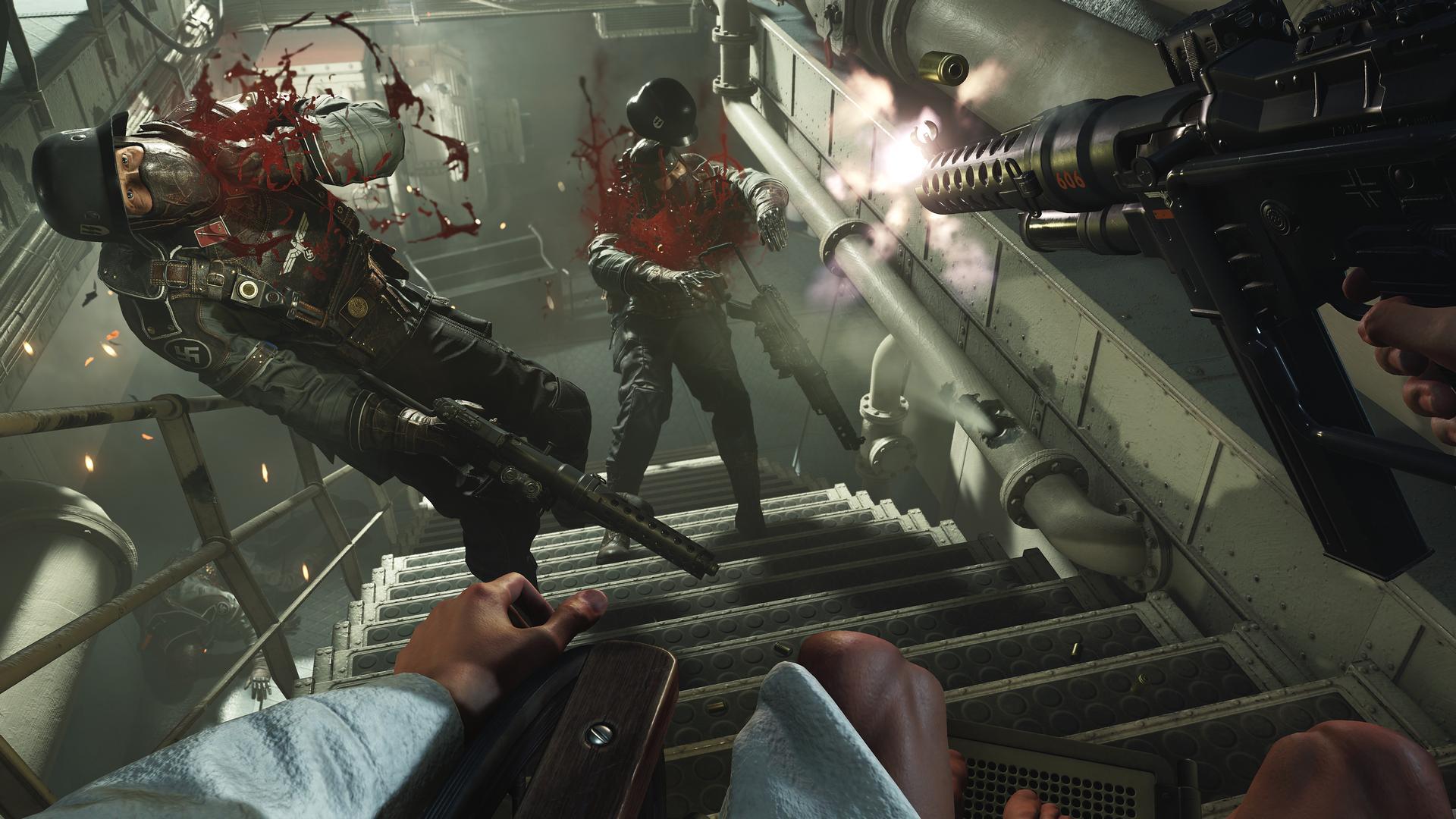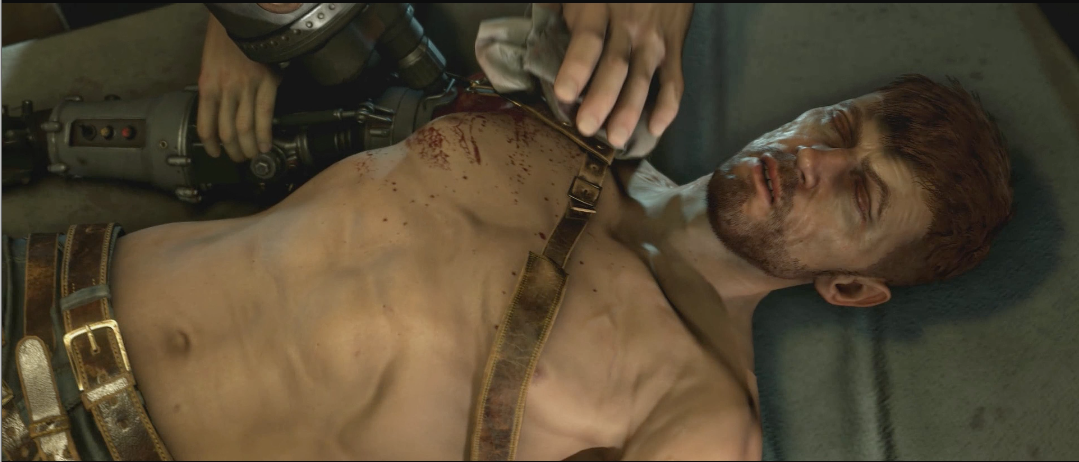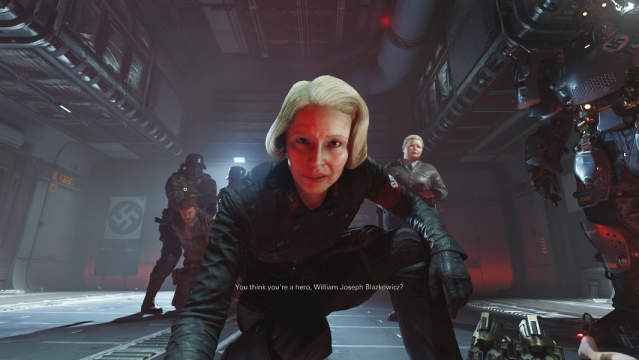Wolfenstein 2: The New Colossus is about injury. From crippled heroes to resistance leaders grappling with PTSD, the game’s cast of heroes bears deep wounds that recall the all-too-real injuries of war veterans, victims, and those who would ignore them.
At the start of The New Colossus, barely awake from a months-long coma and hardly able to stand, protagonist BJ Blazkowicz pulls himself to a wheelchair as Nazis attack the U-boat he and other members of the resistance are using as a home base. His body is scarred, he hardly has the strength to move, and he is peeing into a bag. In spite of this, he takes up a gun and proceeds to shoot the hell out of some Nazis.

The set piece dances a line between pulp absurdity and seething power fantasy. On the one end of the spectrum is BJ: broken, pushing forward through grit alone. On the other end are his Nazi foes: well-armoured, relentless, and physically capable.
Each burst of gunfire draws glorious splashes of blood, painting BJ’s body red with the blood of his enemies. And yet, there is a restriction to his moment. Even in the peak fury of a gunfight, BJ can only move in slow, rhythmic pulses as he pushes his wheelchair.
The New Colossus has a particular fascination with bodies and how they’re perceived.
Among the most common motifs is how many members of the resistance have lasting injuries. BJ bears the marks of countless battles, prominent scars cutting across his face. Resistance leader Caroline Becker is crippled and must rely on powerful armour to engage in battle. The gentle giant Max Hass has a cranial injury that has rendered him differently abled.
Tough-talking Scotsman Fergus Reid has prominent burns on his face. Resistance and war has visible costs, and the core cast of characters visually references that cost through their various injuries.
Shortly after the wheelchair sequence, BJ turns himself over to the Nazi General Irene Engel in order to save his comrade. An extended sequence of torture plays out as Engel brandishes an axe, preparing to kill BJ, Caroline, and Fergus (or Wyatt, if the player has chosen his timeline).
In looking at this collection of broken people and eying BJ’s body, Engel asks a damning question:
“Is this how a hero looks like?”
The implied answer is no. Although Engel herself bears a massive facial scar, a carry-over from an injury sustained in The New Order, she cannot conceive that a hero could ever be wounded. The Nazi fascination with bodies seeks idealised images: blonde-haired and blue-eyed models of hypermasculinity who are untouched.
It’s noteworthy that BJ himself fits much of this. He is a hyper-masculine protagonist, rippling with muscle, and also meets the Aryan ideal: strong features, white, fair-haired. Engel herself complimented these features in The New Order but dismisses them now that BJ is not at his physical peak.

Engel is wrong. Heroes hardly fit into clean visual modes. When I look at The New Colossus’ cast, I see reflections of the heroes we often forget in the real world. Fergus loses his arm in the opening sequence and has a prosthetic grafted on, American resistance leader Grace Walker lets a cigarette burn her when she’s caught up in memories of a bombing, and BJ is further maimed after being captured by the Nazis.
Engel cannot see what is in front of her, conceptualising injured bodies as repugnant. They do not fit the fascist ideal of heroism. There is implicit moral judgement: if these people were true heroes, they would not be so scarred.
America celebrated Veteran’s Day last Saturday, honouring the servicemen and women of our various armed forces. I have complicated thoughts about the mechanisms and missions of our military; our intervention often does more harm than help.
But among the nation’s many struggles is a failure to accommodate our veterans even as we celebrate them; they are sometimes deported or denied essential medical care in spite of their service.
In all of this, I often ask if we remember what heroes can look like. In the real world, war veterans bear plenty of scars as do those caught in the cross-fire. Some, like the man who often rides the same L train I take home, have extensive burns. Others walk on prosthetic limbs.
I doubt Engel would notice them, but they are, like BJ, examples of what heroes look like.

Comments
2 responses to “Wolfenstein 2 Reminds Us What Heroes Look Like”
Does he use torture and intimidation like so many “heroes” in movies and TV do. Beating the crap out of a prisoner is torture, yet it has become commonplace in media
Yeah, in the New Order he uses the threat of a chainsaw to get information out of a Nazi commander, and when he gets the info chops him up any way, or at least that is the implication you don’t actually see it happen.
As to the morality of it, in the context of the world the game takes place that’s pretty tame.
No, actually I’m pretty sure he doesn’t. He’s on the receiving end a few times though.